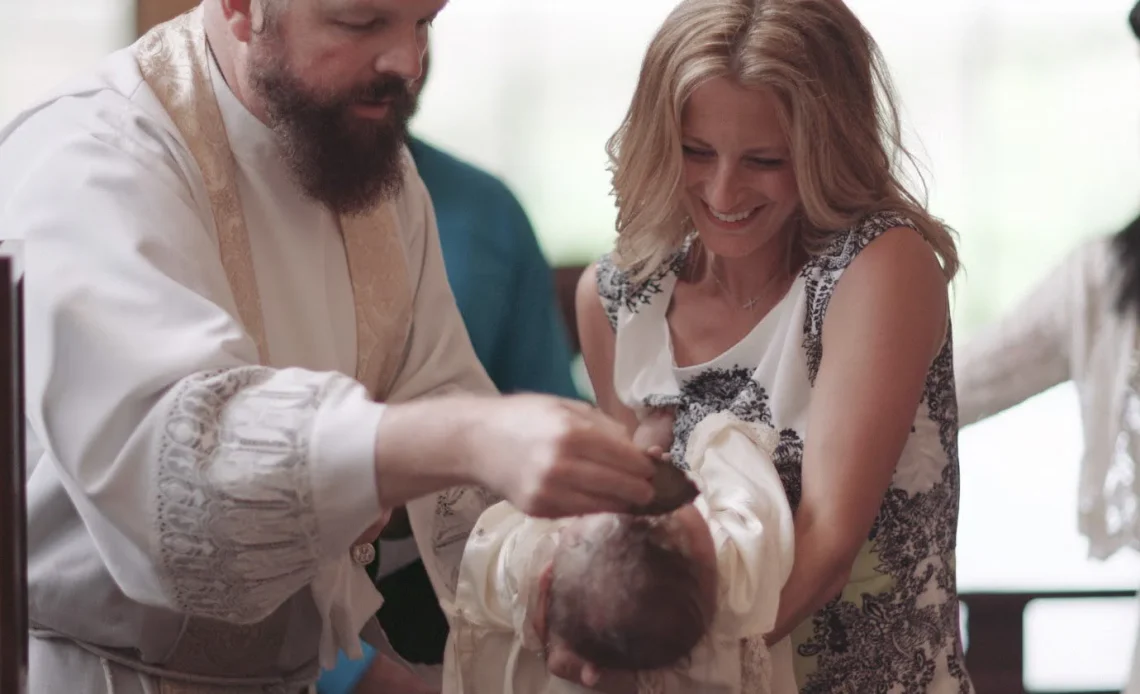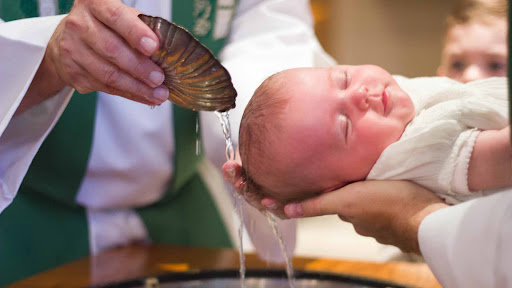
When we hear Infant Baptism explained, many questions often arise: Why baptize babies who cannot yet profess faith? What does the Bible say about it? How does it fit into Catholic tradition? The Catholic Church has always taught that baptism is necessary for salvation (John 3:5) and that this gift of grace is not restricted by age. By baptizing infants, the Church entrusts children to the mercy and love of God, welcoming them into the Christian family from the very start of life.
This article will give a detailed look at Infant Baptism explained from different perspectives: biblical roots, theological significance, Church teaching, and its role in family and community life.
What Is Infant Baptism?
Infant Baptism explained simply means the sacrament by which a child, usually soon after birth, is initiated into the Christian faith. It is not just a ritual or tradition but a sacrament that:
- Washes away original sin.
- Imparts sanctifying grace.
- Incorporates the child into the Body of Christ.
- Begins a lifelong journey of faith under the guidance of parents, godparents, and the wider Church.
Catechism Reference: “The practice of Infant Baptism is an immemorial tradition of the Church. There is explicit testimony to this practice from the second century on, and it is quite possible that, from the beginning of the apostolic preaching, when whole ‘households’ received baptism, infants may also have been baptized” (CCC 1252).
Biblical Foundations of Infant Baptism
Some argue that baptism should only be for adults who consciously profess faith. However, Infant Baptism explained through Scripture shows that the early Church understood baptism as a covenant with God, similar to circumcision in the Old Testament.
-
Acts 16:15 – Lydia and her household were baptized.
-
Acts 16:33 – The Philippian jailer and his family, likely including children, were baptized at once.
-
1 Corinthians 1:16 – St. Paul mentions baptizing the household of Stephanas.
In Jewish tradition, covenants always included children. Baptism as the “new circumcision” (Colossians 2:11–12) naturally extends to infants, showing that God’s grace is not limited to conscious understanding.
Why Parents Choose Infant Baptism
Parents bring their infants for baptism not because the child understands but because of faith, love, and responsibility. Infant Baptism explained from a parental perspective involves three key reasons:
-
Faith and Salvation – Parents desire their child to receive God’s saving grace early.
-
Community Membership – Baptism unites the child to the Christian community.
-
Tradition and Continuity – Parents follow the apostolic and Catholic tradition.
Infant Baptism explained reminds us that it is not merely about personal choice but about sharing the gift of faith within the family and Church.
Role of Parents and Godparents
Parents and godparents play a vital role in Infant Baptism. Since the child cannot profess faith, parents and godparents make promises on behalf of the child. They vow to raise the child in the Christian faith, teaching them prayer, the sacraments, and moral living.
-
Parents’ Role: To be the primary educators of faith.
-
Godparents’ Role: To assist in nurturing the child’s spiritual growth.
This shows Infant Baptism explained as not a one-time event but the beginning of a lifelong journey supported by family and community.
Theological Importance of Infant Baptism
The theology of Infant Baptism explained emphasizes God’s initiative in salvation. Grace is a free gift, not something earned by age, knowledge, or works.
-
Original Sin: Every child inherits original sin (Romans 5:12). Baptism removes this stain.
-
God’s Initiative: Baptism is a sign that God loves us first (1 John 4:19).
-
Salvation: It is the ordinary means by which a person is united with Christ.
The Church affirms that delaying baptism without reason risks denying a child the sanctifying grace needed for Christian life.
Infant Baptism in the Catholic Church Today
The Catholic Church continues to strongly uphold Infant Baptism as the norm. In fact, Canon Law (Canon 867) instructs parents to baptize infants within the first weeks after birth. This shows how central Infant Baptism explained is to Catholic life.
Modern baptism ceremonies involve:
-
Holy Water: Symbol of cleansing and new life.
-
Anointing with Oil: A sign of being sealed with the Holy Spirit.
-
White Garment: Sign of purity.
-
Baptismal Candle: Symbol of the light of Christ.
Common Misunderstandings About Infant Baptism
Some misunderstandings include:
-
“Children can’t have faith.” True, but baptism is about God’s grace, not human understanding.
-
“It should be delayed until adulthood.” Delaying baptism means withholding grace unnecessarily.
-
“It’s just a family tradition.” No, it is a sacrament, not a cultural ritual.
Infant Baptism explained properly clears up these confusions and affirms that baptism is God’s work, not ours.
🌐 You can also read the Catechism of the Catholic Church: Baptism for the official teaching.
Conclusion
Infant Baptism explained shows us that this sacrament is not simply a symbolic act or a family tradition. It is a profound expression of God’s mercy, welcoming children into the faith from the very start. Through it, infants are freed from original sin, filled with sanctifying grace, and united with Christ and His Church.
Parents, godparents, and the Christian community together take responsibility to nurture the faith of the baptized child. This ongoing commitment ensures that baptism becomes the beginning of a lifelong journey in Christ.
❓ FAQs on Infant Baptism Explained
1. What does Infant Baptism mean in the Catholic Church?
Infant Baptism explained in the Catholic Church means welcoming a child into the faith, washing away original sin, and giving the gift of sanctifying grace.
2. Is Infant Baptism found in the Bible?
Yes. While the Bible does not use the exact phrase “Infant Baptism,” households were baptized together (Acts 16:15, 16:33). Infant Baptism explained through Scripture shows it follows the covenant tradition where children are included.
3. Why baptize a baby who cannot understand faith?
Infant Baptism explained teaches that grace is a gift from God, not based on human knowledge. Parents and godparents promise to raise the child in faith until the child can personally confirm it.
4. Does Infant Baptism remove original sin?
Yes. According to Catholic teaching, Infant Baptism explained through the Catechism (CCC 1250) removes original sin and makes the child a new creation in Christ.
5. What is the role of godparents in Infant Baptism?
Godparents assist parents in raising the child in the Christian faith. Infant Baptism explained shows that godparents are spiritual guides and witnesses of faith.
6. What happens if a child dies before baptism?
The Church entrusts such children to the mercy of God. Infant Baptism explained here reminds us of God’s love and hope for salvation, while emphasizing baptism should not be delayed unnecessarily.
7. How soon should parents baptize their baby?
Canon Law (Canon 867) says parents should baptize infants within the first weeks of life. Infant Baptism explained through Church teaching shows this ensures children quickly receive grace.
8. Is Infant Baptism the same in all Christian churches?
No. Infant Baptism explained varies: the Catholic, Orthodox, and some Protestant churches practice it, while others prefer “believer’s baptism” when a person is older.
9. Can an adult who was baptized as an infant be baptized again?
No. Baptism is received only once. Infant Baptism explained highlights that its grace is permanent, though an adult may later receive Confirmation to strengthen faith.
10. How does Infant Baptism differ from dedication ceremonies?
Some Christian groups dedicate children without baptizing them. Infant Baptism explained in Catholic teaching shows that baptism is a sacrament with real spiritual effects, not just a blessing.
11. Do parents need to be practicing Catholics to baptize their child?
The Church requires at least one parent to intend to raise the child in the Catholic faith. Infant Baptism explained reminds us that sacraments are celebrated within the community of faith.
12. Is Infant Baptism required for salvation?
The Church teaches baptism is necessary for salvation (John 3:5). Infant Baptism explained shows it is the ordinary means, though God can work outside the sacraments in His mercy.
13. What symbols are used in Infant Baptism?
Water (cleansing), oil (Holy Spirit), a white garment (purity), and a candle (light of Christ). Infant Baptism explained shows how these signs express spiritual realities.
14. Can someone baptize a baby in an emergency?
Yes. In danger of death, anyone—even a non-Catholic—can baptize with the proper intention using water and the Trinitarian formula. Infant Baptism explained shows how precious baptism is.
15. Does Infant Baptism guarantee heaven?
No. Infant Baptism explained teaches that baptism opens the way to salvation, but living the faith and growing in grace are also essential throughout life.

